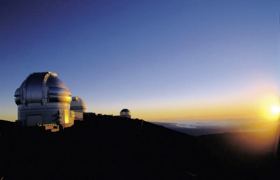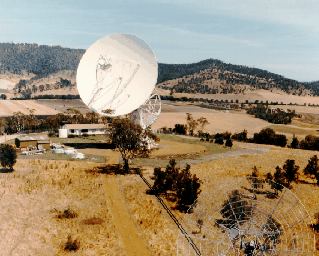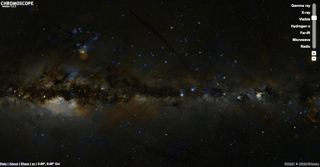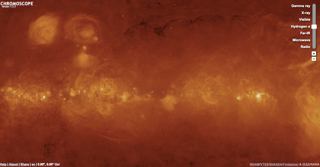|
Welcome to the second edition of the CSIRO Astronomy and Space Science Education Newsletter for 2010. In this issue you'll find:
If you have any questions about CSIRO's astronomy education and outreach activities, please don't hesitate to contact me.
Robert Hollow
Education Officer
CSIRO Astronomy and Space Science
This is a rare opportunity to visit some of the largest telescopes in the world including the Gemini Telescope (image below courtesy Gemini Observatory) atop Mauna Kea on the island of Hawaii as part of the Out and On Top of the World Science Teacher Tour to Hawaii.

This 10-day tour escorted by CASS Education Officer Robert Hollow is open to science teachers across Australia. It includes a workshop on the effective teaching of astronomy by some of the best astronomy educators in the US, a tour of the Gemini Observatory on Mauna Kea and a viewing night from the mountain. We will visit the Hawaii Volcanoes National Park and explore other places of scientific and cultural interest to provide you with a wealth of experiences to bring back to your classrooms.
The tour departs Friday 24 September, returning Sunday 3 October. Cost is approximately $5,400. Places are limited. Details are available here.

This one-day workshop held in collaboration with Scienceworks and the Victorian Space Science Education Centre (VSSEC) at Scienceworks, Spotswood, Melbourne on Wednesday 28 April provides teachers of VCE Physics with skills and resources to tackle these options.
The program includes:
- Ideas for effective teaching of astronomy in the classroom
- An overview of Australian astronomy
- FREE resources for teaching Astronomy & Astrophysics
- How to use authentic astronomy data in your classroom including PULSE@Parkes and Galaxy Zoo
- An overview of VSSEC's Astronomy and Astrophysics programs
- The Melbourne Planetarium VCE Astronomy/Astrophysics show.
Cost is $110 (incl GST) and includes resources and catering. For more details and bookings please visit the VSSEC page

CSIRO Astronomy and Space Science in collaboration with the University of Tasmania is running at two-day workshop on astronomy for high school science teachers 19 - 20 July.

Held at the University's Mount Pleasant Observatory near Hobart, the workshop sessions will provide you with opportunities to:
- trial "hands-on" activities you can take back to the classroom
- meet and listen to Australian astronomers and talk with them about their work and the cosmos
- tour Mount Pleasant Observatory and the Grote Reber Museum
- learn how to run a viewing night for your students and find your way around the night sky using the unaided eye and small optical telescopes (weather permitting)
- use powerful visualisation and other free software tools and learn how to incorporate them in your classes
- take home a range of useful and practical resources and ideas that you can use with your students.
Cost is $250 incl GST. More details and a booking form are available here.

CASS staff will be presenting talks and workshop sessions at CONASTA in Sydney, 4 - 7 July. Sessions include:
- The Stanhope Oration, 18.45 - 19.45 on Monday 5 July will be presented by Dr Brian Boyle, CSIRO SKA Director. His talk is: The Square Kilometre Array: Inspiring the Next Generation and beyond.
- Using Authentic Astronomical Data in the Classroom is a practical workshop session, (Session AB, 11.10 - 13.15 Monday 5th July) presented by Rob Hollow.
- The Pocket Solar System: Galileo Teacher Training Program Astronomy Activities for the Classroom is a hands-on workshop session suitable for all levels presented by Rob Hollow, (Session HI, 11.35 - 1.40 Wednesday 7th July).
For more details visit the CASS teacher workshop page or visit the CONASTA website.

All of the data gathered in the last two and a half years of PULSE@Parkes observations is now freely available online for analysis using our new online module.
The module includes an interactive tutorial and guides students through the data analysis needed to determine the dispersion measure of a selected pulsar. This is then used to estimate the distance to the pulsar and locate it on a projection of the Galaxy. There are opportunities for student investigations and further exploration. The module operates through most web browsers and does not require any special software to be installed.
PULSE@Parkes is conducting an international observing session in collaboration with ASTRON in the Netherlands on 28 May. Dutch high school students will take control of the Parkes radio telescope to gather data on southern sky pulsars. Check the project website for more details. Don't forget, you can follow along with any observing session via our twitter feed; PULSEatParkes.
Other sessions in the next semester will be held in Sydney, Hobart, Perth (tbc) and Melbourne.

This year, high school students in Australia have a chance to use an hour of observing time on one of the world's largest optical telescopes, the 8-metre Gemini South telescope in the Andes Mountains of Chile.
How? By picking an object in the Southern sky and writing a winning explanation of why it would be interesting to digitally photograph. For contest details and to enter visit the contest website (external link). Entries close on Friday 7 May.

One of the requirements of the Stage 5 NSW Science syllabus (Outcome 5.9.1b) is that students learn to:
- identify that some types of electromagnetic radiation are used to provide information about the universe. (Page 37)
In reality astronomers now utilise all parts of the electromagnetic spectrum to gather information about the Universe. Whilst students can readily appreciate the use of optical telescopes to obtain information it can be more difficult for them to visualise the sky at other wavelengths. Fortunately there is now a simple and effective online tool, Chromoscope, that they can use to visualise the entire sky or a portion of it at multiple wavelengths. Developed by astronomers from the Universities of Manchester and Cardiff, Chromoscope runs on a web browser or you can download it to run offline.

As described on the Chromoscope website:
Chromoscope has been created using public-domain datasets from a number of all-sky astronomy projects. It lets you easily move around the sky and fade between wavelengths using a simple user-interface to illustrate the similarities and differences between what is visible at each wavelength.
There are currently seven included: gamma ray (Fermi), X-ray (ROSAT), H-alpha (WHAM), optical (DSS), infrared (IRAS), microwave (WMAP) and radio (Haslam). You can click on the credit information, shown at the bottom-right of the Chromoscope screen, to learn more about each survey.
The image above shows part of the sky in the visible waveband whilst the image below shows the same region at the Hydrogen-alpha waveband.

You can toggle constellation lines and labels on and off and can even run it from a USB stick for times when you don't have web access. The beauty of Chromoscope is its simplicity and minimal interface.

Your Subscription
You can update or delete your newsletter subscription details at any time by contacting robert.hollow@csiro.au
Please be assured that you will only receive CASS Education E-Newsletter and your email address won't be used for any other purpose.

|